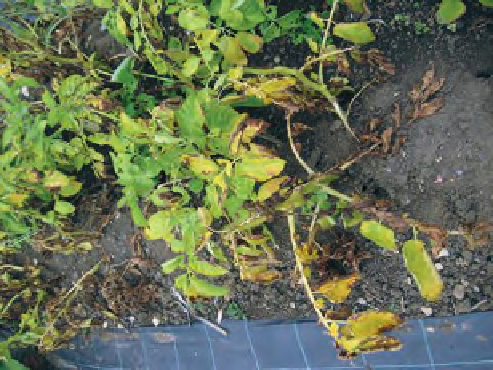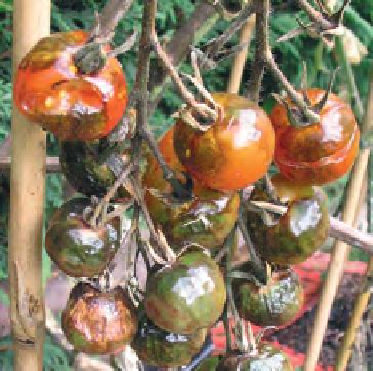Agriculture Reference
In-Depth Information
increase under favourable conditions, but
then may decline. Resident organisms such as
Pseudomonas
spp. may be weakly parasitic on
plants, but more commonly persist (often for
considerable periods) without causing damage,
and on a wide variety of plants.
There is increasing evidence that phyllosphere
bacteria may reduce the infection of diseases
such as powdery mildews,
Botrytis
diseases
on lettuce and onion, and turf grass diseases.
Practical disease control strategies by
phyllosphere organisms have not been
developed, but there remains the general
principle that a healthy, well-nourished plant
will be more likely to have organisms on the leaf
surface available to reduce fungal infection.
There are also phyllosphere fungi such as
Alternaria
,
Cladosporium
and
Fusarium
that
are commonly found on leaf surfaces and these
may prove to be useful in combating fungal
disease infection in a similar way to the bacteria
described above.
same (or similar) fungicide active ingredient. For
example, the potato blight 'fungus' is closely
related to the damping-off 'fungi' and the downy
mildew 'fungi', and these three types of 'fungi'
are effectively controlled by fungicide active
ingredients containing copper salts. Because
of the horticulturally practical aspects of fungal
classification, the appropriate fungal division
is given for each disease as it appears in the
text (for example, the division 'Zygomycota' is
mentioned against potato blight, damping off
and downy mildew).
Potato blight (
Phytophthora
infestans
)
This fungus is a member of the Zygomycota division
of fungi (see p. 62).
Damage
. This important disease is a constant threat
to potato production, and caused the Irish potato
famine in the nineteenth century. The first symptoms
seen are yellowing of the foliage, which quickly goes
black and then produces a white bloom on the under-
surface of the leaf in damp weather. The stems may
then go black, killing off the whole plant. The tubers
may have dark surface spots that, internally, appear
as a dry, deep red-brown rot. This 'fungus' may attack
tomatoes, the most notable symptom being the dark
brown blisters on the fruit (Figure 19.4).
Life cycle
. The fungus survives the winter
as mycelium and sexual spores in the tubers
(Figure 19.5). The spring emergence of infected
shoots results in the production of asexual spores.
Spread
. The spores are spread by wind, land on potato
leaves or stems and can, after infection, result in a
further crop of spores within a few days under warm
wet weather conditions. The disease can spread very
Fungal diseases
Practical relevance of fungal
classification
The classification of fungi referred to on
p. 62 has some practical implications in
understanding fungal disease life cycles and
control. Species within a fungal 'division' often
have similar methods of spread, and of survival.
Their similarity of spore structure, of hypha
structure and of biochemistry also means that
they are often susceptible to control by the
(a)
(b)
Figure 19.4
Potato blight: (a) leaf symptoms on potato; (b) fruit symptoms on tomato








